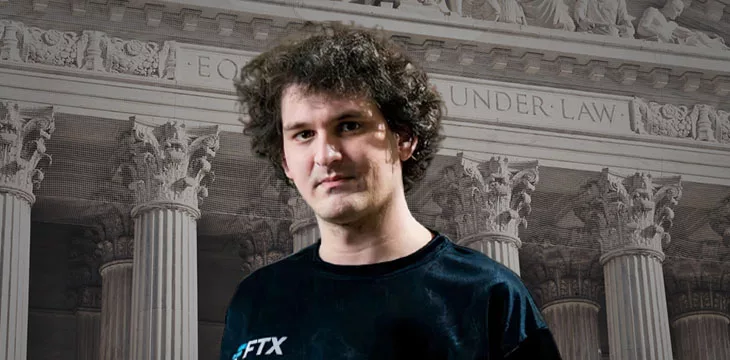|
Getting your Trinity Audio player ready...
|
As the criminal trial of disgraced FTX founder Sam Bankman-Fried (SBF) takes a breather, we recap the previous week’s highlights, lowlights, and some very dim bulbs.
SBF’s fraud and money laundering trial took last Friday off and won’t resume action until October 26, which gives us a chance to summarize the major episodes from last week’s drama. Not the least of which was SBF finally getting a change to his Adderall prescription, which the perpetually-fidgeting-not-at-all-tweaking-like-a-methhead SBF claims help his attention deficit disorder.
After having his normal dosage of 12 bottles of Adderall per hour [satire alert] restricted to two daily doses by his Manhattan jailers, SBF was granted permission last Thursday to switch to an extended-release version of the stimulant. SBF’s attorneys had argued that SBF’s withdrawal symptoms were negatively impacting his ability to participate in his own trial, offering the tantalizing possibility that, if suitably doped, he’ll take the stand to testify when the defense presents its case.
But enough future-surfing. When we last left our hero, Caroline Ellison, SBF’s ex-girlfriend/CEO of FTX’s market maker Alameda Research, had wrapped up two days of testimony in which she repeatedly kicked her ex in the gonads while his attorneys failed to land a punch during their cross-examination.
We’ll start with testimony from Zac Prince, former CEO of bankrupt digital asset lender BlockFi, which SBF had made a very public bid to acquire shortly before FTX itself went under. While SBF was painted as the white knight of ‘crypto’ at the time, we now know that his real goal was to get his hands on BlockFi customer assets to partially plug the hole in FTX after Alameda ‘borrowed’ (and lost) billions in FTX customer funds.
On the stand, Prince proved the latest ‘crypto’ luminary who publicly preached the mantra of ‘don’t trust: verify’ while doing the exact opposite. Prince testified that BlockFi “always relied on the information that we were given by counterparties to be truthful and accurate,” so he took SBF at his word that all was tickety-boo with FTX/Alameda.
SBF’s team tried to get Prince to pin the fraud on Ellison, but Prince said he was “messaging and emailing with Sam at the time” they discussed the acquisition. Prince’s understanding was that, while Ellison signed the papers, she’d done so “at Sam’s instruction.” Uh, no more questions, your honor.
Nishad Singh
Monday brought the first appearance of Nishad Singh, FTX’s former head of engineering, who, like Ellison, struck a deal with prosecutors for his role in FTX’s demise. Singh knew SBF long before he was famous, having been friends with SBF’s younger brother Gabe in high school. Singh said on the stand that while he’d “had a lot of admiration and respect” for SBF, “over time a lot of that eroded.”
Part of that erosion was due to what Singh perceived as SBF’s wasteful spending on unnecessary luxuries, like the infamous $30 million Bahamas group residence, whose residents included Singh. SBF’s nine- and 10-figure investments in dubious ventures and paying tens of millions of dollars to buy clout with celebrities also rubbed Singh the wrong way. But when he challenged SBF on some of these decisions, Singh said SBF angrily dressed him down in front of others, accusing Singh of “sowing seeds of doubt” and calling Singh “the real insidious problem here.”
As for his role in the fraud, Singh said he personally designed the system that began directing FTX customer deposits into Alameda bank accounts in 2019. (FTX had trouble getting U.S. banks to take its business, so they set up the North Dimension shell to serve as a financial pass-through to Alameda.) Singh said someone at FTX would “manually credit” these deposits to FTX user accounts to maintain the illusion.
Notably, the individual(s) in charge of this system forgot to manually tweak the fake numbers when FTX customers withdrew funds from the exchange. This discrepancy between what was owed to customers and what was actually on hand grew to a staggering $8 billion before Singh and others took notice.
At the “advisement and direction” of SBF and FTX co-founder/CTO Zixiao ‘Gary’ Wang, Singh coded the ‘special privileges’ Alameda enjoyed on FTX, including the immunity from liquidation if Alameda’s account went negative. But Singh claimed ignorance that Alameda would be given free rein to wholesale loot FTX customer deposits.
Singh did cop with cooking the revenue books in spreadsheets that were sent to investors that put a healthier spin on FTX’s fiscal reality. But Singh claimed that he didn’t understand the extent to which FTX had been hollowed out until two months before its bankruptcy when SBF announced plans to mothball Alameda to improve FTX’s image. Ellison told Singh this was “impossible” given the scale of Alameda’s debts, which is when Singh said he understood that “customers had been betrayed.”
Singh said he then confronted SBF one-on-one, but SBF said, “I’m not sure what there is to worry about.” SBF dismissed the missing billions as FTX being “a little short on deliverable,” nothing that couldn’t be smoothed over by raising new capital from investors.
Singh also claimed that SBF asked him to transfer the personal supplies of (SBF-founded decentralized exchange) Serum tokens from SBF, Singh, Wang, and Ellison to Alameda to improve its balance sheet. SBF then told Singh to backdate these transfers. Singh said he never followed through because he knew he’d have to justify it to a skeptical regulator later on.
Singh also detailed his extensive role in facilitating SBF’s tens of millions of dollars in political campaign contributions (again, with FTX customer cash), but since the campaign finance charges have been deferred to a separate trial, we’ll defer rehashing them here.
When the defense had the opportunity to grill Singh on Tuesday, they failed to put serious dents in his earlier testimony but scored a few minor blows. For instance, the defense got Singh to admit that his altruistic plans for the $477 million ‘loan’ he received from FTX in late 2021 never materialized.
Other benefits Singh enjoyed from FTX’s excesses included buying a $3.7 million home in Washington State in October 2022. Given his claim that he learned in September 2022 that FTX was billions in the red, he would have well understood that his real estate deal was paid with funds that could only have come from FTX customers. (Singh later forfeited the property.)
Wednesday
On Wednesday, prosecutors offered a roundup of SBF’s harebrained post-bankruptcy media tour, including his chat with a Vox reporter that he retroactively claimed was off the record. The defense tried (in vain) to convince Judge Lewis Kaplan to prevent these conversations from being shown to the jury, claiming these damning admissions of having engaged in “unethical shit” were “devoid of context.”
Prosecutors scored more hits when Peter Easton, an accounting expert and Notre Dame professor who assisted government prosecutors in the Enron and WorldCom fraud trials, testified with a series of simple diagrams illustrating how one could determine how much of SBF’s investments were made with FTX customer cash.
Among the investments cited by Easton funded with customer cash were the aforementioned campaign contributions, the $500 million stake in AI firm Anthropic, around half of the $2.1 billion buyout of Binance’s stake in FTX in 2021, the stake in Anthony Scaramucci’s Skybridge Capital, the $400 million stake in the Modulo Capital hedge fund and—perhaps most awkwardly for SBF—the $16.4 million spent on the Bahamas home for his parents Joseph Bankman and Barbara Fried.
In trying to refute Easton’s easy-to-follow charts, the best the defense could manage was to argue that fiat cash is fungible, and therefore, it was impossible to tell FTX customer cash from operating capital. The defense also honed in on what it claimed were mislabeled entries in Easton’s diagrams, but overall, it appears to have been a pretty weak pushback.
The prosecution closed Wednesday with a former FTX lobbyist who offered confirmation of statements SBF made in his various appearances before and written testimony submitted to Congress. Prosecutors made sure to highlight SBF’s claims of transparency, responsible risk management, and the fact that FTX “have never had customer losses, clawbacks or anything like that.”
Thursday
The week’s final court day saw prosecutors shift tack, putting former FTX attorney Can Sun on the stand. Despite joining FTX in August 2021, Sun—who hasn’t been charged with any crimes related to FTX’s downfall—claimed he was ignorant of Alameda’s ‘borrowing’ of FTX customer funds until August 2022.
Among Sun’s more jarring revelations was that, as SBF was talking to investors about a potential late-stage bailout, SBF asked Sun for possible explanations he could give investors regarding the missing billions on FTX’s balance sheet. Sun said he gave SBF a couple “theoretical arguments,” with the caveat that “none of them was supported by the facts.”
Despite this warning, Sun said SBF later used one of these dodges—customers’ use of the ‘borrow-lending’ aspect of FTX’s margin trading business—in SBF’s post-bankruptcy interview on ABC’s Good Morning America. (Host George Stephanopolous wasn’t buying it either.)
The prosecution may wind up its case when the trial resumes on October 26, after which SBF’s team will have a week to 10 days to present its case. God knows what Hail Marys they’ll attempt to pitch at the jury, including possibly hearing from SBF himself, although that will give the prosecutors their own crack at him, which likely would be disastrous for his case, with or without a sufficient supply of Adderall.
Follow CoinGeek’s Crypto Crime Cartel series, which delves into the stream of group—from BitMEX to Binance, Bitcoin.com, Blockstream, ShapeShift, Coinbase, Ripple,
Ethereum, FTX and Tether—who have co-opted the digital asset revolution and turned the industry into a minefield for naïve (and even experienced) players in the market.

 12-18-2025
12-18-2025 




